
MANUFACTURER'S SPECIFICATIONS
Amplifier Section
Rated Power Output: 75 watts per channel, 8 Ohm loads, 20 Hz to 20 kHz.
THD: 0.1%.
IM Distortion: Less than 0.1%.
Main Input Sensitivity: 1.5 V.
Frequency Response: 1 watt, 5 Hz to 50 kHz ±1 dB.
Preamplifier Section
Rated Output Level: 1.5 V.
THD at Rated Output: 0.05%.
IM Distortion at Rated Output: 0.02%.
Frequency Response: Phono, RIAA ±0.5 dB; Aux, 20 Hz to 20 kHz ±0.3 dB.
Input Sensitivity: Phono and Mike, 1.8 mV; Tape or Aux, 180 mV.
Phono Overload: 300 mV. Tape Out Level: 0.775 V.
S/N Ratio: Phono re: 7.5 mV input, 78 dB; Aux re: 775 mV, 88 dB.
GENERAL SPECIFICATIONS
Dimensions: 15 3/8 in. W x 5 3/4 in. H x 12 3/8 in. D.
Weight: 33 lbs.
Price: $499.95; $399.95 for model 1150, without Dolby system.
Now that the Dolby noise reduction system has been adopted by many FM and stereo FM stations, there are several ways in which you can take advantage of the greater dynamic range and quieter reception inherent in this broadcast system. You could, of course, purchase a new tuner equipped with both Dolby decoding and the proper 25 uS de-emphasis. If you already own a good tuner not so equipped, you could add a separate Dolby box plus a small accessory that converts signal output to the proper de-emphasis (or you could rewire your tuner for 25 NS de-emphasis). Or, you could consider Marantz's new 1150D integrated amplifier if you happen to be looking for a new control/amp unit with just about every conceivable control feature plus Dolby encode and decode facilities that can be used in conjunction with your tape equipment. Interestingly, all that Dolby circuitry will effectively cost you only $100.00, because Marantz's Model 1150, an integrated amplifier that's similar to the 1150D sells for that much less than the Dolbyized version we tested.
The front panel of the Marantz 1150D has a centrally positioned, vertically deflecting meter used together with the built-in 400 Hz generator for calibrating record and playback of Dolbyized tapes. Above the meter is a pilot light and flanking the meter are three slide controls on each side, each with click-stop positions, for adjustment of bass, treble, and mid-range response on an individual channel basis.
Symmetrically positioned pairs of rotary control knobs at the left and right ends of the panel select Dolby operation mode, tape monitoring (two tape monitor circuits are provided), program mode (left, right, stereo, reverse, and mono-mix), and adjust master volume level. The Dolby Mode switch has positions for playing back Dolby FM, playing other Dolbyized program sources, non-Dolby listening, making Dolby recording from "flat" program sources and making "flat" recordings from Dolby-encoded program sources. Six pushbuttons at the upper left of the panel select program sources (including two phono inputs, the second of which may be used for microphone amplification) and tape copying (from either tape input to the other). Symmetrically placed pushbuttons at the upper right take care of loudness compensation, low and high-cut filter activation (two high-cut frequencies are available: 5 kHz and 9 kHz) and select alternate turnover points for the bass and treble tone controls (250 Hz and 4 kHz as opposed to the "normal" mid-frequency pivot points). The lower, gold colored section of the panel contains push-buttons for the 400-Hz test tone, left or right channel level indications on the Dolby level meter, audio muting, tone defeat, main and remote speaker system selection and power on/off. Centered below the meter is a horizontally moving slide lever control for channel balancing. Two pairs of rotary controls adjust recording and playback level for proper Dolby calibration. Microphone input jacks, dubbing in and out jacks, and a 'phone jack complete the front panel layout.
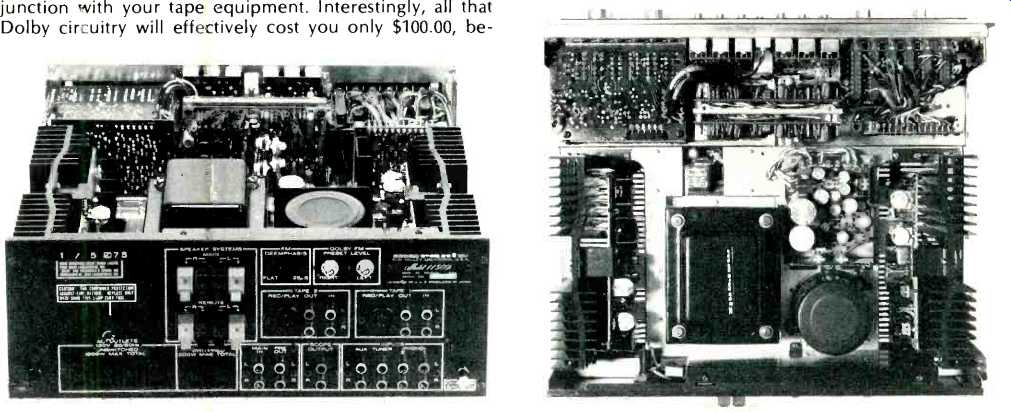
Fig. 1-Rear panel.
Fig. 2-Interior view.
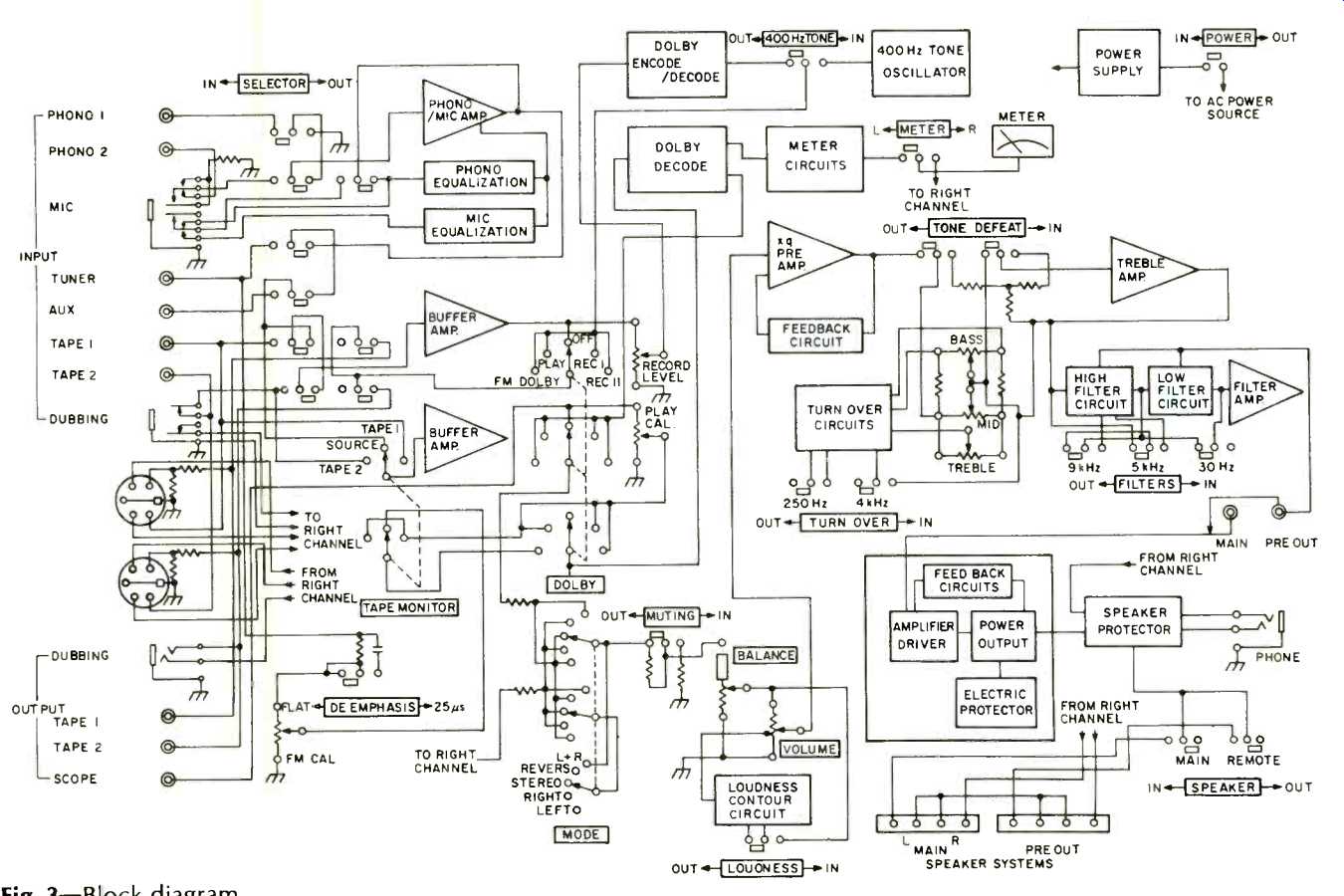
Fig. 3-Block diagram.
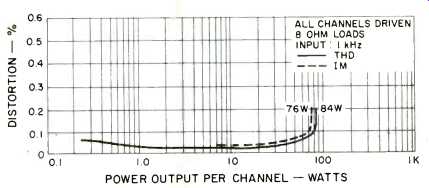
Fig. 5-Harmonic and IM distortion characteristics.
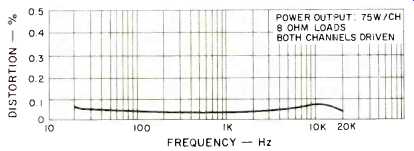
Fig. 5-Distortion vs. frequency.
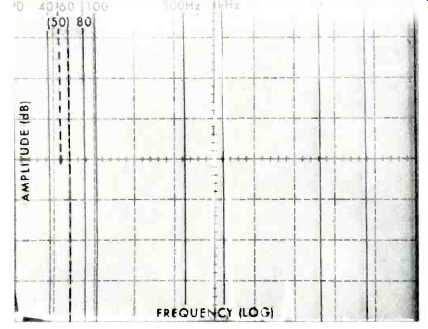
Fig. 6-Spectrum analysis of THD at the rated output of 75 watts per channel
at 1 kHz.
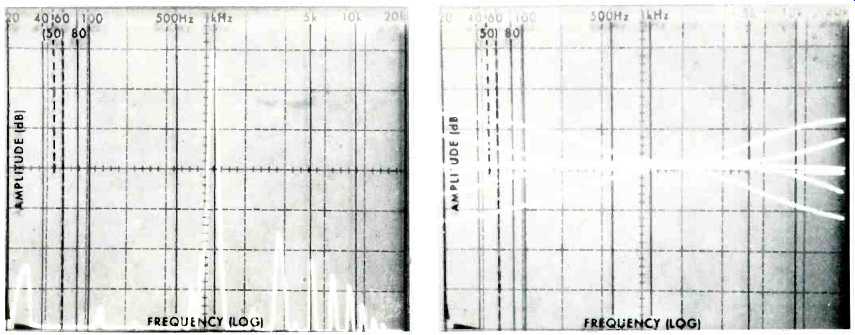
Fig. 7-Spectrum analysis of THD when amplifier is driven to severe clipping.
Fig. 8-Bass and treble control range at each of two turnover settings.
The rear panel of the 1150D, pictured in Fig. 1, has spring loaded speaker terminals for two stereo pairs of speakers, five convenience a.c. outlets (two switched, three un switched), two sets of tape in and tape out jacks (plus DIN connectors for each circuit), preamp-out/main amp-in jacks, 'scope output jacks (for connection to an oscilloscope for observation of phasing, balance, and channel separation), and the usual program source input jacks. In addition, there is a slide switch, for choosing 25 NS FM de-emphasis in the event that your tuner is not equipped with this feature, and a pair of Dolby FM level preset controls to permit adjustment of level from any tuner so that it will match Dolby circuitry in the amplifier for correct decoding. A line fuse holder and chassis ground terminal are also located on the rear panel.
Circuit Configuration
An internal view of the Marantz 1150D is shown in Fig. 2 and a block diagram of the system is reproduced in Fig. 3.
The phono amplifier section consists primarily of a differential input transistor pair, a constant current source stage and a high gain stage. It is powered by a symmetrical bipolar supply to increase overload input capability. The tone control amplifier consists of a unity gain stage using a continuously variable RC-feedback arrangement. From the pre amp-out terminals, signals are fed to the power amplifier section. A differential amplifier and pre-driver circuit amplify the signal to high enough levels to drive the output stages. Each output stage consists of complementary symmetry transistors designed for high current and heat dissipation capabilities. The amplifier stages are direct coupled throughout.
The 1150D contains electronic protection circuits which sense excessive output current and voltage conditions and limit signal to the driver stages to a safe, predetermined value, protecting output transistors and drivers from excessive overdrive and short-circuits. Thermal compensation is also included and a speaker protection relay is provided to disconnect speakers automatically in the event of transistor failure. This relay is also activated by a time delay circuit which keeps speakers disconnected for about four seconds after turn-on to prevent audible popping noises from reaching the speakers during power supply stabilization periods.
Power Output Measurements
After one hour of preconditioning at one-third rated power (25 watts per channel fed to both inputs, outputs connected to 8-Ohm resistive loads), the amplifier was measured for maximum power output capability. It delivered an impressive 84 watts per channel at rated THD of 0.1 per cent at mid-frequencies and an even more impressive 80 watts per channel at the 20 Hz frequency extreme. With 4-Ohm loads, available power increased to 125 watts per channel at mid-frequencies for rated distortion. Results of our 8-Ohm load measurements are plotted in Fig. 4, and distortion remains well under 0.1 per cent all the way from 250 milliwatt output levels to rated output. IM distortion reached 0.2 per cent at an output of 76 watts per channel, again with both channels driven. Distortion versus frequency for a constant 75 watts output per channel is plotted in Fig. 5, and at no frequency did it exceed 0.07 per cent. While Marantz guarantees the full-power frequency range from 20 Hz to 20 kHz, in fact, the amplifier was able to deliver its full rated power of 75 watts at any frequency from 16 Hz to 29 kHz at or less than 0.1 per cent THD. Much emphasis has been placed recently on the distortion content of an amplifier, rather than on the absolute percentage value read by a single meter-type distortion analyzer. To investigate the spectral makeup of the distortion, we used our spectrum analyzer to scan from 20 Hz to 20 kHz while a 1 kHz signal was applied to produce full rated output (75 watts per channel). As can be seen in the 'scope photo of Fig. 6, at rated output (the tall peak in the display is the fundamental 1 kHz signal), distortion product consisted almost entirely of third-order harmonic, which was some 64 dB below full output. Second-order harmonic distortion was down over 70 dB. Also of interest is the harmonic distortion content of the signal produced by an amplifier when it is driven well into clipping. In the case of the Marantz 1150D, even-order harmonics (second and fourth) are seen, in Fig. 7, to be well below odd-order harmonic contributions, while odd-order components decrease in amplitude quite rapidly. Each vertical division of the 'scope presentation equals 10 dB.
Preamplifier Section Measurements

Fig. 9-Action of mid-range tone control and high-and low-cut filters.

Fig. 10-Dolby decode response at various signal levels from Dolby calibration
level downward.
Phono input sensitivity for the Marantz 1150D measured just over 2.0 mV and phono input overload occurred with signal inputs of 340 millivolts at 1 kHz (well beyond the claimed 300 mV, which is in itself most impressive). Phono hum measured 66 dB below full output referred to maximum input sensitivity. Translated to Marantz's reference of 7.5 mV, the phono hum and noise figure would be -77.5 dB, a half dB short of spec. RIAA equalization was accurate to within 0.5 dB from 20 Hz to 20,000 Hz with the greatest error occurring at the high end. Overall frequency response through the high level inputs was flat to within 1 dB from 10 Hz to 35 kHz, and hum level referred to maximum input sensitivity for high level inputs (188 mV) measured 85 dB. Again, translating these figures to the Marantz input reference of 775 mV would give us a S/N ratio of 97 dB. Bass and treble control range for each of the selectable turnover points was recorded on a storage oscilloscope swept from 20 Hz to 20 kHz and is reproduced in Fig. 8. The advantage of selectable turnover tone controls is clearly evident from this photo since, when the 250 Hz and 4 kHz settings are chosen, it becomes possible to adjust response at the frequency extremes without seriously affecting musical response in the mid-frequency region.
Action of the mid-range boost and cut control was photographed separately, using the same spectrum analyzer sweep technique, together with the response of the single low-cut and dual high-cut filters, all of which are pictured in Fig. 9. Note the steeper slope of the high-cut filters (12 dB per octave) compared with the more gradual attenuation characteristic of the treble cut control which has been superimposed on the storage 'scope for comparison purposes.
Finally, we checked the action of the Dolby recording circuits for decreasing levels of input signal, after referencing an input signal to the correct point of Dolby calibration by means of the self-contained Dolby level meter. Results are shown in the 'scope photo of Fig. 10 in which the familiar Dolby action (attenuation of highs increasingly with decreased signal levels) is apparent.
Listening and Use Tests
Our first reaction to the inclusion of all those Dolby options in an integrated amplifier was to question whether, indeed, Dolby belongs in such a product. After using the amplifier for a few days (hooked up to an FM tuner and a variety of cassette and open-reel decks), we began to appreciate the idea and agree that if, indeed, the 1150D is used as the heart of a system, then having Dolby facilities for all applications at that one central point in a system certainly simplifies things.
Tone controls on the amplifier work very well indeed and are so precise in their action that we could detect no difference when they are set to flat as against listening to the system when tone controls are fully defeated. The Marantz 1150D had no problem with any of the low-efficiency speaker systems with which we auditioned its performance and rarely clipped on program peaks even when we opened things up to beyond reasonable listening levels. Continued use at high listening levels resulted in only moderate increases of heat sink temperatures. The front-panel dubbing jacks will appeal w recordists who like to copy tapes from friends' machines.
In short, there's not much Marantz could have added to this top-of-the-line integrated amplifier, and, in our view, the 1150D is definitely in the Marantz tradition of excellence. The 'scope output jacks are obviously intended to convince users to purchase the companion 150 Marantz tuner (which happens to have a 'scope built in), but one cannot fault the Marantz people for that, since the combination would make a truly fine high fidelity system.
-Leonard Feldman(Audio magazine, Mar. 1976)
Also see:
Marantz Model 2500 Stereo FM/AM Receiver (Equip. Profile, Feb. 1978)
Marantz PM-94 Integrated Amplifier (Dec. 1988)
Marantz Model 50308 Stereo Cassette Deck (Dec. 1978)
= = = =